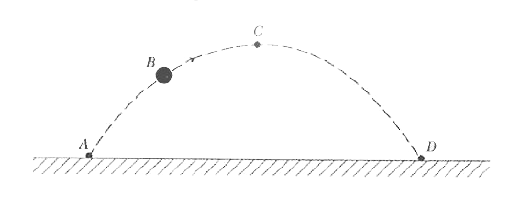Complete Solutions to PRACTICE QUESTIONS (LINKED COMPREHENSION) of chapter MOTION IN TWO AND THREE DIMENSIONS of Class 12 book with complete answers and questions
| Class 12 | PHYSICS |
| Chapter | MOTION IN TWO AND THREE DIMENSIONS |
| RESNICK AND HALLIDAY | PRACTICE QUESTIONS (LINKED COMPREHENSION) |
| Number Of Questions | 14 |
| Academic Year | 2023-24 |
During a one-hour trip, a small boat travels 80.0 km north and then travels 60.0 km east.
What is the boat's displacement for the one-hour trip?
View SolutionDuring a one-hour trip, a small boat travels 80.0 km north and then travels 60.0 km east.
What is the direction of the boat's average velocity for the one-hour trip?
View SolutionA projectile fired from a gun has initial horizontal and vertical components of velocity equal to 30 m/s and 40 m/s, respectively.
At what angle is the projectile fired (measured with respect to the horizontal)?
View SolutionA projectile fired from a gun has initial horizontal and vertical components of velocity equal to 30 m/s and 40 m/s, respectively.
Approximately how long does it take the projectile to reach the highest point in its trajectory?
View SolutionA projectile fired from a gun has initial horizontal and vertical components of velocity equal to 30 m/s and 40 m/s, respectively.
What is the speed of the projectile when it is at the highest point in its trajectory?
View SolutionA projectile fired from a gun has initial horizontal and vertical components of velocity equal to 30 m/s and 40 m/s, respectively.
What is the acceleration of the projectile when it reaches its maximum height?
View SolutionA projectile fired from a gun has initial horizontal and vertical components of velocity equal to 30 m/s and 40 m/s, respectively.
What is the magnitude of the projectile's velocity just before it strikes the ground?
View SolutionA shell is fired with a horizontal velocity in the positive x direction from the top of an 80 m high cliff. The shell strikes the ground 1330 m from the base of the cliff. The drawing is not to scale.

What is the speed of the shell as it hits the ground?
View SolutionA shell is fired with a horizontal velocity in the positive x direction from the top of an 80 m high cliff. The shell strikes the ground 1330 m from the base of the cliff. The drawing is not to scale.

What is the magnitude of the acceleration of the shell just before is strikes the ground?
View SolutionA tennis ball is thrown upward at an angle from point A. It follows a parabolic trajectory and hits the ground at point D. At the instant shown, the ball is at point B. Point C represents the highest position of the ball above the ground.

While in flight, how do the x and y components of the velocity vector of the ball compare at the points B and C?
View SolutionA tennis ball is thrown upward at an angle from point A. It follows a parabolic trajectory and hits the ground at point D. At the instant shown, the ball is at point B. Point C represents the highest position of the ball above the ground.

While in flight, how do the x and y components of the velocity vector of the ball compare at the points A and D?
View SolutionA tennis ball is thrown upward at an angle from point A. It follows a parabolic trajectory and hits the ground at point D. At the instant shown, the ball is at point B. Point C represents the highest position of the ball above the ground.

Which statement is true concerning the ball when it is at C, the highest point in its trajectory?
View SolutionA man at point A directs his rowboat due north toward point B, straight across a river of width 100 m. The river current is due east. The man starts across, rowing steadily at 0.75 m/s and reaches the other side of the river at point C, 150 m downstream from his starting point.

What is the speed of the river?
View SolutionA man at point A directs his rowboat due north toward point B, straight across a river of width 100 m. The river current is due east. The man starts across, rowing steadily at 0.75 m/s and reaches the other side of the river at point C, 150 m downstream from his starting point.

While the man is crossing the river, what is his velocity relative to the shore?
View Solution
PRACTICE QUESTIONS (LINKED COMPREHENSION) questions and complete solutions for chapter MOTION IN TWO AND THREE DIMENSIONS of RESNICK AND HALLIDAY PHYSICS (HINGLISH) of Class 12